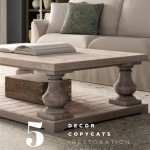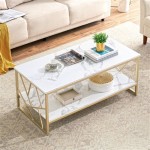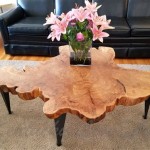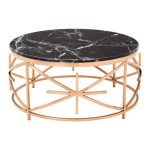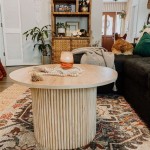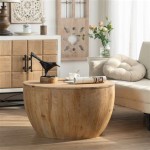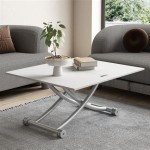```html
How To Style a Circular Coffee Table
A circular coffee table serves as a focal point within a living space, offering both aesthetic appeal and functional utility. Styling it effectively requires careful consideration of its shape, size, and overall design aesthetic. The aim is to create a visually balanced and practical surface that complements the surrounding furniture and reflects the individual's personal style.
Unlike rectangular or square coffee tables, the round form lacks defined edges, presenting a unique challenge and opportunity for stylists. Its curves soften the rigid lines often found in sofas and armchairs, contributing to a more inviting and harmonious ambiance. Effective styling transforms the coffee table from a mere surface into a curated composition, displaying carefully chosen objects that express personality and enhance the room's overall design scheme.
Understanding the Principles of Styling
The foundation of successful coffee table styling lies in understanding core design principles. Balance, proportion, and visual hierarchy play crucial roles in creating an appealing arrangement. Balance, in this context, refers to the distribution of visual weight across the table. Symmetry can be achieved by mirroring identical objects on opposite sides, while asymmetry involves using different objects of varying sizes and textures to create visual interest.
Proportion dictates the relationship between the objects and the table itself. Oversized items can overwhelm a small table, while minuscule details might get lost on a larger surface. The goal is to select objects that are proportionate to the coffee table's dimensions and to each other.
Visual hierarchy guides the eye, creating a focal point and drawing attention to key elements. This can be achieved by varying the height and scale of objects, placing taller items towards the center and gradually decreasing the height towards the periphery. The purpose is not to overcrowd the table but to create points of interest that tell a story and engage the viewer. An effective arrangement blends functionality with aesthetics, providing a surface for practical use without sacrificing visual appeal.
Key Elements for Coffee Table Styling
Several key elements contribute to a well-styled coffee table. These include books, decorative objects, trays, plants, and personal items. The selection and arrangement of these elements will depend on the individual's style and functional needs.
Books are a versatile styling tool, adding height, texture, and personality. Stacked horizontally, they create a platform for displaying smaller objects. Arranged vertically, they offer visual interest and a touch of intellectual sophistication. The choice of books should reflect personal interests and complement the room's overall aesthetic. Consider using coffee table books with visually appealing covers and spines, or select books that relate to the room's design theme.
Decorative objects encompass a wide range of items, including sculptures, vases, bowls, and candles. These objects add character and visual interest, reflecting the individual's style and personality. When selecting decorative objects, consider their size, shape, and texture. Varying the materials and finishes will add depth and complexity to the arrangement. A sculptural object can serve as a focal point, while a set of decorative bowls can add functionality and visual appeal.
Trays provide a sense of order and containment, grouping smaller objects together and preventing the arrangement from feeling cluttered. They also serve as practical surfaces for serving drinks or snacks. Trays come in various shapes, sizes, and materials, allowing for customization to suit the table's style and the individual's taste. A metal tray can add a touch of glamour, while a wooden tray can create a more rustic feel.
Plants add life and vibrancy to a coffee table arrangement, introducing natural elements and softening the overall look. A small potted plant or a vase of fresh flowers can instantly brighten up a room. Consider the plant's size and shape, ensuring that it complements the table's dimensions and does not obstruct the view. Succulents, ferns, and orchids are popular choices for coffee table styling, requiring minimal maintenance and adding a touch of elegance.
Personal items, such as family photos, souvenirs, or travel mementos, add a personal touch and make the coffee table arrangement more meaningful. These items reflect the individual's history and personality, creating a sense of connection and belonging. When incorporating personal items, consider their size and scale, ensuring that they complement the other elements and do not overwhelm the arrangement. A framed photograph or a small collection of souvenirs can add a unique and personal touch to the coffee table.
Arranging Objects on a Circular Coffee Table
Arranging objects on a circular coffee table requires a different approach than styling a rectangular or square table. The lack of defined corners necessitates a more fluid and organic arrangement. One common approach is to divide the circle into quadrants or sections, creating distinct areas for different objects. This can be achieved by visualizing the table as a pie, with each slice representing a different zone.
Another approach is to create a central focal point, arranging objects around it in a circular pattern. This can be a tall vase, a sculptural object, or a stack of books. The surrounding objects should complement the focal point and create a sense of balance and harmony. Avoid overcrowding the table, leaving enough space for practical use.
Consider the height and scale of the objects when arranging them. Varying the height will create visual interest and prevent the arrangement from feeling flat. Place taller objects towards the center and gradually decrease the height towards the periphery. Overlapping objects can create depth and complexity, adding visual interest to the arrangement.
Pay attention to the color palette and textures of the objects. Coordinating the colors will create a cohesive and harmonious look, while varying the textures will add depth and complexity. Consider using contrasting colors and textures to create visual interest and highlight key elements. For example, a smooth ceramic vase can be paired with a rough wooden tray to create a dynamic contrast.
Regularly reassess and adjust the arrangement. Coffee table styling is an ongoing process, and the arrangement should be updated periodically to reflect changes in personal style or seasonal trends. Remove items that are no longer needed or that feel outdated, and replace them with new objects that add freshness and vibrancy to the space. Consider rearranging the objects to create a new look and feel, experimenting with different combinations and layouts. The goal is to create a coffee table arrangement that is both visually appealing and functionally practical, reflecting the individual's style and enhancing the overall design of the living space.
```
Style A Round Coffee The Easy Way Stonegable

Style A Round Coffee The Easy Way Stonegable

How To Style A Round Coffee Table Decor Fix

The Basics Of Coffee Table Styling Shades Blue Interiors

How To Style A Round Coffee Table Studio Mcgee Decor Living Room

Tips For Styling A Round Coffee Table Taryn Whiteaker Designs

How To Style A Round Coffee Table Nikki S Plate

How To Style A Round Coffee Table Decor Fix

How To Style A Round Coffee Table Decor Fix

How To Style A Round Coffee Table Nikki S Plate Decor Living Room
